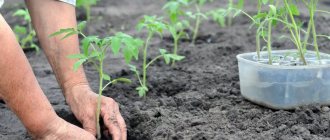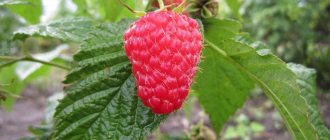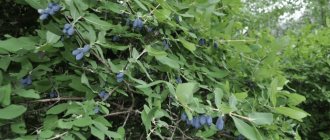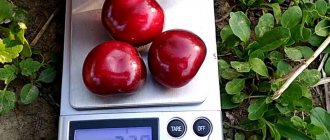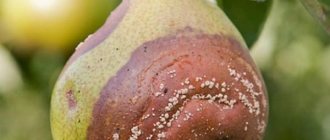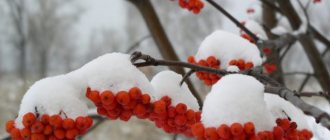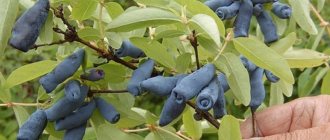What is remarkable about Polana raspberries?
Polana was bred in 1991 at the Research Institute of Pomology and Plant Science in Poland. It was created as a result of the hybridization of Heritage and Zeva varieties. crop is remontant, that is, it bears double fruit. Berries are formed on last year's and one-year-old shoots.
Raspberry Polana - an unpretentious variety of Polish selection
Characteristic features of the variety:
- A bush of medium height, as a rule, reaches 1.5–1.6 m. The shoots are straight, thick, quite strong, do not bend under the weight of berries and do not need a trellis. The surface of the stems is covered with small thorns.
- The leaves are colored rich green on top and have a whitish-green color on the reverse side.
- The berries are conical in shape, medium in size, reaching a weight of 3–6 g. The color of the fruit is dark crimson, there is a well-defined characteristic aroma. The skin is dense, due to which raspberries have a relatively long shelf life and are resistant to transportation . The fruits are juicy with a sweet and sour taste. The drupes are small.
- The yield indicators are good; from one hundred square meters it is possible to harvest up to 200 kg of raspberries. During the fruiting period, the berries are located from the middle to the top of the shoots, this occupies up to 70% of the bush.
Polana is a productive variety that is not afraid of aggressive growing conditions.
The Polana variety has some special features. This raspberry is characterized by high shoot formation: 40–50 shoots per bush. The culture can withstand frosts down to -32°C.
Polana can grow in one area for 14 years, while other varieties deplete the soil after only 4 years. Read about another fertile raspberry variety - Taganka - a delicious raspberry
Video: description of Polana raspberries
Characteristics of the variety
According to experienced summer residents, Polana raspberries have fruits of a regular cone shape, as well as cultivation potential. A shrub can grow in one place for 10 years, without loss of yield and quality of berries. Features of Polana raspberries are presented in the video.
Drought resistance, frost resistance
Raspberry is a moisture-loving plant, but Polana can only withstand short periods of lack of moisture. A longer period has a negative effect on the formation of ovaries, and the leaves also wither.
The fruit shrub variety is able to withstand temperatures down to -32 °C. The berries can still ripen at a temperature of +5 °C.
Productivity
Fruiting of raspberries of the Polana variety is considered abundant. From a bush with 4 shoots it is possible to collect 4–5 kg of berries. According to statements from the originator of the variety, the yield varies between 11–12 kg/sq. m - it all depends on the quality of agrotechnical measures. Externally, the bush looks strewn with red fruits. With dense planting, the harvest volume increases, the average is 12 kg/sq. m. With proper care, you can get up to 200 kg of ripe fruits per season from your personal plot.
Judging by the characteristics and reviews, Polana raspberries taste sour. Weather conditions affect the amount of sugar in the berry. Only with sufficient sunlight do raspberries become sweet. Thus, with the onset of autumn, the taste will change.
Unlike other remontant varieties, Polana raspberries have early fruiting periods, but when fully ripe the fruits do not fall off. If they are not removed, they will stay on the shoot until they dry out.
Application area
Polana raspberries are collected every 2–3 days, but it is permissible to extend the period to once every 5–7 days, since the fruits do not fall off. For marketability, harvesting should be done towards the end of the day.
For storage and transportation, the berries are placed in small containers. In deep containers, the fruits will be crushed, so it is recommended to use plastic containers with a volume of up to 1 liter. Raspberries can stay in the refrigerator for about 7 days without visible signs of spoilage. Deep freezing makes it possible to preserve fruits for up to six months.
Attention! The Polana raspberry variety is the leader in commercial cultivation. This is due to the fact that during transportation the berries are not crushed and juice does not appear.
Fresh Polana raspberries are used for preparing fruit salads, purees, and decorating desserts. The berries are great for preserving compotes, jams, confitures, preserves.
Resistance to diseases and pests
The Polana raspberry variety is quite resistant to diseases and pests. But, like any plant, it is afraid of pests. The most dangerous for Polana raspberries are weevils, spider mites, raspberry beetles, and aphids. The variety is remontant and many parasites do not have time to adapt. However, this is not a reason to cancel preventive measures. Common diseases: gray rot, anthracosis, overgrowth.
Advantages and disadvantages of the variety
When describing the remontant raspberry variety Polana, you need to familiarize yourself with the characteristics and reviews of the sensors. Thus, the strengths of the berry bush will become clear, including:
- good yield;
- cold resistance of roots;
- long fruiting period;
- small seeds in berries;
- long-term storage;
- disease resistance;
- after ripening, the fruits do not fall off;
- easy reproduction;
- transportability of the crop.
The disadvantages of Polana raspberries are:
- abundant growth of root shoots;
- low drought resistance;
- susceptibility to verticillium wilt;
- need for tying.
Advantages and disadvantages - table
| Advantages | Flaws |
| High fruiting rates | Low drought tolerance |
| Early ripening (first ten days of August) | Intensive growth of shoots |
| Winter hardiness | |
| Long-term fruiting | |
| Ripe berries are not prone to shedding | |
| Transport resistance | |
| Good preservation of berries |
Reviews about growing Polana
4 ten-liter buckets of berries were collected from 13 planted bushes. Crops must be placed at a distance of at least 80 cm. A lot of juice is obtained from the berries with a small number of seeds. I like that you don’t have to fold it down for the winter.
Valentin Ivanovich, Krasnodar
The Polana variety has average resistance to heat. Although it grew well for us even without drip watering. There were generally excellent results with irrigation. For beginning gardeners, this is the best variety to cultivate.
Elya, Vologda
The variety is valuable for its excellent transportability.
We took it according to the description - easy to care for and productive. And so it turned out - I was pleased with the minimum amount of care for the bushes; there was no need to install supports. But to avoid freezing in the winter, you have to mulch thoroughly. It grew especially well next to the fence, where there are no strong winds. Margarita Stepanovna, Belgorod
Landing Features
Polana, like other raspberry varieties, prefers well-lit areas. This is a prerequisite for obtaining a high yield. In bushes located in shaded areas, fruiting is significantly reduced. Gardeners often practice planting on the south side of fences or buildings.
Polana planting occurs in autumn or spring
There are no strict requirements regarding soil type. Polana is recommended to be planted on sandy loam, chernozem or loamy soils. But this variety can grow in all types of soil. The acidity should be low, the occurrence of groundwater should be at a level of 1–1.5 m from the surface of the earth.
Important! It is not advisable to place raspberries near eggplants, tomatoes, potatoes, peppers, onions, blackberries, rose hips, roses, apple trees or stone fruit trees. Also, these crops should not be the predecessors of Polana.
It is recommended to choose the last ten days of September for planting . The temperature regime during this period maximizes the survival rate of the plant. But this can be done in the spring, in April.
Choosing a healthy seedling is the key to successful crop growth
When purchasing a seedling, you need to pay attention to the following:
- Carefully examine its root system and shoots. The plant should have two to four stems (at least 1 cm thick).
- You should not purchase raspberries with dried or damaged roots. They must be flexible and durable.
Polana is planted in sandy, loamy soil or black soil.
The landing features are as follows:
- For raspberries, prepare a hole 50 cm deep and the same width. A distance of 70–80 cm is maintained between bushes, and 2 m between rows.
- To prepare a soil nutrient mixture you will need: two buckets of humus and peat, 2 liters of wood ash, 5 tbsp. l. azophosphate and superphosphate. These fertilizers are mixed well with the soil removed from the pit. Nutrients should not be brought into the hole in their pure form, as this will lead to burns of the roots.
- A third of the hole is filled with soil mixture, forming a mound.
- Then a seedling is placed on it and the roots are laid out well.
- The pit is completely filled with soil. The root collar is left 5 cm above the ground.
- The soil around the bush is slightly compacted and the raspberries are watered with 5–7 liters of water.
- After this, the ground is loosened and covered with a layer of compost or peat up to 10 cm thick.
Video: practical planting tips
Reviews from gardeners
Alexander, 56 years old, Moscow region
I purchased Polana raspberries five years ago based on the description of the variety. The plant has taken root well in the local climate. If you fertilize with manure, the raspberries will grow 1.5 m, and the berries will be large. Closer to autumn, the berries are not so sweet, so I use them for jam.
Anna, 45 years old, Ulyanovsk
The variety Polana impressed with its productivity. By the beginning of August, the bush is strewn with berries. Picking them is a pleasure - the Polana raspberries are large and juicy. Can be stored for several days.
Egor, 47 years old, Ufa
I had heard a lot about remontant raspberries, so I purchased the Polana variety. The raspberries turned out to be surprisingly productive. The shrub grows quickly, minimal care is sufficient. The berries are sour, not everyone will like them. For the winter, I cover the raspberries with special material to protect them from freezing.
Plant care
Watering and loosening the soil
The soil around the bushes must be systematically loosened to ensure air access to the root system. During the season, the procedure is carried out 5-6 times:
- in early spring;
- as weeds appear and crusts form;
- late autumn (last).
Near the bushes, the soil is loosened to a depth of 5–7 cm, and between the rows - to 10–15 cm.
Important! The raspberry root system is superficial. Therefore, if loosened too deeply, the plant can be damaged.
Watering raspberries is an important step in caring for the crop.
The Polana variety requires regular and abundant watering, since moisture deficiency negatively affects its development and fruiting. You can do this in two ways:
- using grooves - dig holes 15 cm deep on both sides of the bushes at a distance of 40 cm and supply water into them;
- sprinkling method - moistening is carried out using special irrigation installations consisting of pipelines and nozzles.
Watering from a hose with a sprayer is also allowed.
Table: features of watering raspberries
| Watering period | Water consumption per bush |
| Last ten days of May | 20–30 liters of water |
| June - 2 waterings (every 14 days) | |
| July - 2 waterings (every 14 days) | |
| Early August | |
| End of october |
Rules for applying fertilizers
In spring and autumn, the bushes are fed with mineral and organic elements. And in June, the soil around the raspberries is mulched with cow or horse manure in a layer of up to 10 cm.
Polana needs feeding for abundant fruiting
Table: order of fertilizer application
| Feeding time | Nutritional composition per plant |
| April or May | 1 shovel of mullein per bucket of water |
| October | 3 buckets of peat and 100 g of urea or ammonium nitrate |
Bush pruning
Bushes are pruned in October or November. This will help increase future harvests, as well as protect raspberries from viruses and pests . The shoots are pruned, leaving stumps 3 cm high. In April, frozen and dried stems are shortened to a healthy bud. Root growth is also completely removed. Otherwise, it will take some of the nutrients from the soil, which will negatively affect the development of raspberries.
Pruning raspberries will strengthen the bush
There is no need to cover Polana for the winter. The stems are completely removed in the fall, and the root system of this raspberry is highly frost-resistant. There will be enough snow cover for the plant.
Important! Pruning is performed after frost, since before this period shoots and leaves still continue to supply the root system with nutrients.
Video: master class on bush pruning
Growing and care
Raspberries with the Polana variety planted in open areas, especially in large volumes, need to be tied to trellises. The first two years, when the bushes are not large, they do not bend much from the wind and the harvest, but then, the unfixed huge branches will bend, get tangled, and take up a lot of space in the rows. It is difficult to care for such plantings, and part of the harvest is also lost.
Watering
Polana raspberries are characterized by poor drought resistance, so abundant, timely watering is one of the main aspects of agricultural technology when growing this variety. Of course, you need to take weather conditions into account. The main thing is that the soil is always moist at a depth of 25-35 cm. In the southern regions, where the heat evaporates and disappears quickly, it is recommended to install drip irrigation or dig ditches along the rows for irrigation. It is better to sprinkle water in the evening or early in the morning, since in the sun drops of water can serve as optical lenses and burn the leaves.
Watering is also required before applying fertilizers to the soil.
Trimming
In recent years, more and more gardeners have been growing remontant raspberry varieties in an annual cycle. Although a one-time harvest begins to ripen a little later, it is of high quality, is not affected by pests, almost all of it has time to ripen, and also does not deplete the bushes and soil, as with a double harvest. With this cultivation in the fall, the entire above-ground part of the bushes is cut off completely at the root. The branches and leaves are taken out and must be burned. In the summer, when new shoots grow above 160-180, their tops are pinched, and excess, weak branches are also cut out. Superfluous, because the Polana bush produces up to 20-25 shoots per season, and to get good quality berries, you need to leave 7-10 of the strongest branches in the bush.
Feeding
As already mentioned, Polana raspberries are generous in yield and in the formation of green mass of the bush, so you can’t do without fertilizing. The expended resources must be compensated by applying fertilizers at least 2-3 times per season, starting 3-4 years after planting.
It is important to remember that nitrogen fertilizers (fresh manure, mullein, saltpeter, green manure) are needed for the growth of stems and leaves. Mineral fertilizers (wood ash, compost, potassium salt, superphosphate) are needed for the quantity of ovaries and the quality of the fruit. Therefore, you periodically need to bring organic matter and forest soil to the site, sow mustard or clover, prepare compost, herbal infusions, collect ash, etc.
In late autumn or early spring, manure, humus, and saltpeter are added, and at the time of flowering and berry formation, ash, compost, and complex mineral fertilizers are added.
Reproduction
A large number of root shoots allows gardeners to plant Polana in any quantities.
Preparing for winter
After cutting off the shoots, the root part of the plantings is covered with spruce branches or covered with a thick layer of peat, straw, or humus - any material that is available on the site.
For those who grow Polana in a two-year crop, the shoots need to be bent low to the ground for the winter, also covered. Without shelter, on trellises, bushes of this variety can suffer at temperatures below 20 degrees, and especially from frost after a thaw.
Diseases and pests
To avoid the development of diseases and pests, attention should be paid to preventive measures. If it was not possible to prevent the damage, then it is necessary to begin treating the plant as soon as possible.
Table: diseases affecting raspberries
| Diseases | Symptoms | Treatment methods | Prevention |
| Septoria |
|
|
|
| Anthracnose |
| ||
| Chlorosis |
| Enriching the soil with nutrients: adding peat, compost or humus every 2 years at the rate of 5 kg per 1 m2. |
|
| Canker spot (cancer of stems) |
|
|
|
| Bushiness | A lot of discolored thin short stems are formed in the bush, which are collected in a bunch. | Regular fertilizing. | |
| Purple spot |
|
|
|
Photo gallery: typical cultural diseases
Anthracnose causes berries to drop
Bushiness can completely destroy a crop
Purple spot threatens stems
Raspberry stem cancer damages shoots, weakening the bush
Septoria blight damages raspberry leaves
Chlorosis leads to slower development of the bush and loss of yield
Table: plant pests
| Pests | Signs | Ways to fight | Prevention measures |
| Shoot gall midge |
| Treatment after fruiting with Karbofos solution (30 g of composition per 10 liters of water). |
|
| Aphid |
| The use of Karbofos at the stage of bud break. | Pruning all stems in autumn. |
| Stem fly |
| Spraying bushes at the budding stage with Iskra (5 ml of composition per 5 liters of water). | Loosening the soil under a bush. |
| Weevil | Females make holes in the buds and lay eggs in them, causing the buds to dry out. |
|
|
| Raspberry beetle |
| Treatment of bushes before flowering and at the stage of bud formation with Karbofos (75 g per 10 l). | Digging the soil to 20 cm. |
| Spider mite |
|
|
|
Photo gallery: parasites typical for the variety
Weevil damages raspberry buds
Raspberry beetle eats berries
Spider mites suppress the foliage of bushes
Shoot gall midge damages young stems Stem fly can deprive most of the crop
Aphids eat shoots and leaves
Features of harvesting and storage
The berries reach ripeness in early August. The productivity of one bush is 4–6 kg. Fruiting continues until the onset of frost. Depending on the climatic conditions of the region, the berries are harvested before October or November. Collection is carried out in sunny, dry weather. The stalks are not separated from the fruits. Raspberries are placed in baskets with a capacity of 2–3 kg and stored in the refrigerator. Berries of the Polana variety do not lose their appearance and taste for four days.
Important! Despite the fact that the stems of Polana are covered with thorns, their scarcity and small size make harvesting quite convenient.
In addition to fresh consumption, the fruits are used to make jam, jelly, and compotes. Raspberries are also added to cocktails and confectionery. For long-term storage, Polana is frozen or dried:
- spread in one layer on a baking sheet, then keep in the oven for five hours at 50–60°C. Dried raspberries can be stored in an airtight jar for up to two years;
Polana is an excellent variety for preparations and desserts
- To freeze, the berries are placed on a plate or tray and placed in a chamber for several hours. When the fruits harden, they are poured into a plastic bag. Then they are placed in the freezer, where they will be stored until the next harvest.
Trimming and garter
This raspberry variety does not require garter. However, some gardeners do it out of habit. The stems are strong enough to grow without any additional help. However, pruning is necessary.
Here's how it's done:
- First, all dry shoots are removed.
- Then the branches are examined for the presence of traces of various diseases. They differ in color or have characteristic swellings.
- At the end, you need to shorten the skeletal branches to one meter in height. It is also worth thinning out the bushes to get larger shoots.
All removed branches after pruning must be burned. If they are placed in a hole with humus, the fertilizers may become contagious. Since raspberry shoots often contain pathogenic microorganisms. When they get into soil with humus, they infect other crops.



